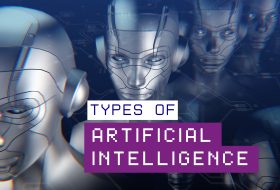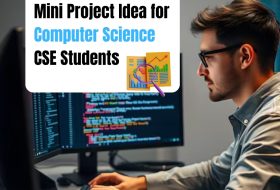The tumultuous arrival and rise of artificial intelligence have also brought on unprecedented transformation in the educational sector which has been impervious to change for the longest time. The world is on the brink of a new educational revolution in consonance with the fourth industrial revolution. Going by the appellation -Education 4.0, the teaching and learning landscape is geared for a transformative future with the integration of AI and advanced technologies.
STEM and AI researchers are full-on about AI revolutionizing the learning method. Like AI enabling more interesting, simulative and impactful learning experiences for students, it is also poised to lighten teacher’s workload and enable them to engage in more crucial tasks. This AI and educational sector intersection is not a possibility but an imminent change. To get a complete grasp of how to embrace and navigate through this transition, understanding the potential of AI and the opportunities it offers is essential. Moreover, like any other innovations that have graced the world, the marriage of the educational sector and AI is not without limitations and challenges, all of which require attention. It is a fact that only through informed and responsible adoption can the world truly witness and fulfil the potential of AI to its optimum.
This article aims to introduce the manifold opportunities, the consequent challenges and remedial solutions going to shape and redefine the educational landscape in the next few years. For one, it will prepare you for the meteoric change. Two, you will have a foundational knowledge of the numerous opportunities awaiting in the educational sector and most importantly, it will keep you highly informed about AI and education intersection.
Understanding Artificial Intelligence and Its Functions in the Education Space
Artificial Intelligence is a technology that sanctions machines and computers the power to execute tasks just as humans by simulating the human capacity of learning, understanding, decision-making, problem-solving, creativity and autonomy. In short, AI refers to the simulation of human intelligence by machines. It operates by processing large sets of labelled training data and then analyzing them to uncover patterns and correlations in order to make informed predictions.
The marriage of AI and education is insipient and the world is still learning the dynamics of integrating AI technologies in education, in terms of ethical critical issues, safety and equity. However, there are a few imminent functions that AI is projected to perform for a revolutionary educational space.
Educational games powered by AI
The adage “All work and no play makes Jack a dull boy” also applies to education significantly. Educational institutions have long recognized the importance and value of play-based learning and have made efforts to introduce play as an integral component of learning, particularly at the early stages of learning. The integration of AI is revolutionizing the development of educational game designs aimed at offering interactive and personalized learning experiences.
Development of adaptive learning platforms
Edtech leaders today are increasingly offering adaptive learning platforms for learners that feature real-time customized learning activities and content. These systems also offer space for immediate feedback and continuous assessment and enable systems to fine-tune their approach, content, learning pace and difficulty level by using the data collected from the learning sessions. This method greatly enhances student’s engagement and learning outcomes.
Automated and efficient administrative work
The integration of AI in education is significantly useful and of great value for automating administrative tasks including planning, grading students’ performance, attendance tracking, scheduling and identifying institutional weak areas that need attention. This efficient streamlining of administrative tasks gives teachers and staff the scope to focus on more crucial tasks.
Intelligent Tutoring Scope
With AI, students can now access one-on-one support and learning opportunities in a similar manner as that of having a human tutor. This method helps in addressing specific learning gaps or understanding complicated subjects, like Mathematics or language, etc.
These are some of the major current trends that have taken shape as key roles and functions that AI offers in its marriage to education. Let us explore what other opportunities will the AI and educational sector intersection offer in the coming future.
Opportunities of AI in Education: Towards Accelerated Improvement and Success
Coupled with heightened popularity, the attitude towards AI in education has significantly improved, with educators and institutions making efforts to integrate, explore and experiment with the potential of AI to achieve optimum growth and success. In this section, let us explore the notable opportunities foreseeable in the next few years:
Augment and automate the role of teachers
As AI helps streamline administrative tasks and other workloads of the teachers, it can significantly aid in addressing the shortage of educators at the global level. The demand for qualified teachers to improve educational outcomes is a formidable challenge, with projections to surge in the next few years. By streamlining and automating tasks, teachers can engage in a more meaningful task and teaching and also create a conducive environment for teachers to thrive, ultimately leading to a wholesome learning experience.
Improving educational assessment and analytics
From delivering timely feedback and enabling more focused engagement, educators have ample opportunities to harness the power of AI in their pedagogy. By leveraging AI, teachers are empowered with an accelerated assessment process and also gain real-time analysis of the student’s performance. Through this, teachers are capable of identifying individual students’ strengths and weaknesses and can devise targeted teaching strategies. Predictive analytics equip teachers to offer timely intervention and thereby improve learning outcomes.
Enhanced learning experiences
The introduction of technologies like Virtual Reality and Augmented Reality ( VR & AR) will greatly impact the learning experience of the students as they engage in an immersive environment facilitating deeper understanding. It is one of the notable promises of AI to make complex concepts more accessible and understandable.
Accessibility with Inclusivity: One of the major opportunities that AI in Education promises is the scalability of quality education and democratizing it to make learning opportunities and resources available across the globe. It can aid in bridging the educational divide and bring quality education closer home to every learner. This method can remedy the problem of limited educational facilities and infrastructure in remote areas.
Future-ready Individuals: It is indisputable that the world is heading towards a fully tech-driven future where digital literacy will become a fundamental necessity. Digital skills are vital for student’s future employability and ethical use of technology. The integration of AI in education offers an avenue for students to develop and hone digital education. Technological and digital literacy has become an imperative today, projected to intensify further in the future.
Challenges and Solutions for Embracing AI in Education
Concerns for Data Privacy
Handling sensitive student data is one of the biggest challenges. Concerns over data privacy and protection have emerged with the need for AI in education requiring the aggregation and analysis of students’ personal and sensitive data. Protecting this data and information is paramount as both the students and institutions are at risk of facing the repercussions of data breaches.
Solution: The way forward for this hurdle is to ensure confidentiality and security by implementing a robust framework of data governance. Institutions must ensure using the students’ collected data only for the targeted purpose and must not be shared with third parties without consent.
Issue of Equitable Access: While AI progressively democratizes educational access, it will fail to bring the gap of technological accessibility, meaning, it will continue the widen the already existing gap between those with technological access and those without. This displays a picture where students deprived of technological privilege are left behind and the availability of access to advanced educational opportunities only to those with technological access.
Solution: Ensuring equity in educational innovative designs must be the priority of every institution. Also, collective effort must be given by all stakeholders to ensure equitable access to technology and AI tools to ensure the benefits of AI in education and every aspect reach far and wide.
Skill gap among educators
As the integration of AI in education is a new concept, teachers who are intimidated by new technology face the technical gap and inability to provide the same for the students.
Solution: Instituting thorough training for educators and instilling a culture of acceptance and open-mindedness to technological integration. They should be reminded that AI is only a tool to help automate academic tasks but it will never be a replacement for human-led teaching. They should be well-trained to deliver lessons via AI-powered technology. Digital literacy for both students and teachers is key to taking the educational landscape forward.
The rise of AI and its impact on the educational landscape cannot be overstated or disregarded. It is undoubtedly a challenging task yet embracing this ever-powerful technology for the benefit of education requires a thoughtful and inclusive approach. Developing education-centred AI technologies must acknowledge and include the roles of educational institutions, educators and parents and should be co-designed collaboratively. Such innovations must be designed appropriately and pragmatically to meet the needs and demands of the classroom, in tune with curriculums and must equally ensure safeguarding the security of the student’s data.










